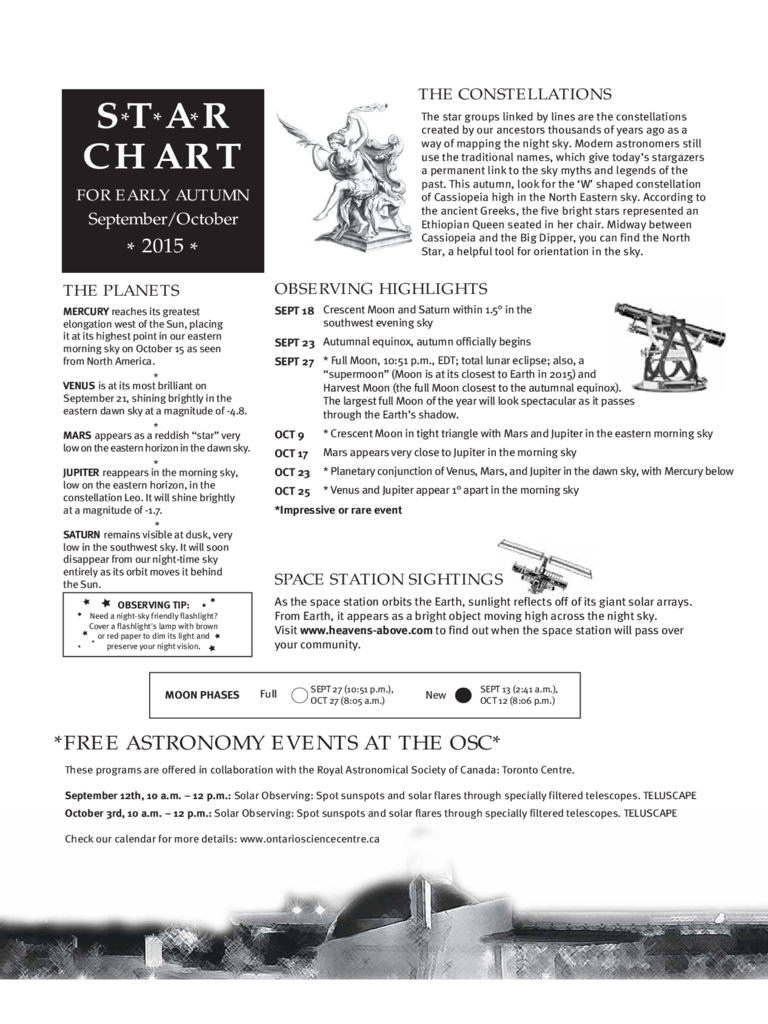Fillable Printable 2015 Star Chart
Fillable Printable 2015 Star Chart

2015 Star Chart

** *
SPACE STATION SIGHTINGS
As the space station orbits the Earth, sunlight reflects off of its giant solar arrays.
From Earth, it appears as a bright object moving high across the night sky.
Visit www.heavens-above.com to find out when the space station will pass over
your community.
THE PLANETS
MERCURY reaches its greatest
elongation west of the Sun, placing
it at its highest point in our eastern
morning sky on October 15 as seen
from North America.
*
VENUS
is at its most brilliant on
September 21, shining brightly in the
eastern dawn sky at a magnitude of -4.8.
*
MARS
appears as a reddish “star” very
low on the eastern horizon in the dawn sky.
*
JUPITER reappears in the morning sky,
low on the eastern horizon, in the
constellation Leo. It will shine brightly
at a magnitude of -1.7.
*
SATURN
remains visible at dusk, very
low in the southwest sky. It will soon
disappear from our night-time sky
entirely as its orbit moves it behind
the Sun.
*FREE ASTRONOMY EVENTS AT THE OSC*
These programs are offered in collaboration with the Royal Astronomical Society of Canada: Toronto Centre.
September 12th, 10 a.m. – 12 p.m.: Solar Observing: Spot sunspots and solar flares through specially filtered telescopes. TELUSCAPE
October 3rd, 10 a.m. – 12 p.m.: Solar Observing: Spot sunspots and solar flares through specially filtered telescopes. TELUSCAPE
Check our calendar for more details: www.ontariosciencecentre.ca
OBSERVING TIP:
Need a night-sky friendly flashlight?
Cover a flashlight's lamp with brown
or red paper to dim its light and
preserve your night vision.
The star groups linked by lines are the constellations
created by our ancestors thousands of years ago as a
way of mapping the night sky. Modern astronomers still
use the traditional names, which give today’s stargazers
a permanent link to the sky myths and legends of the
past. This autumn, look for the ‘W’ shaped constellation
of Cassiopeia high in the North Eastern sky. According to
the ancient Greeks, the five bright stars represented an
Ethiopian Queen seated in her chair. Midway between
Cassiopeia and the Big Dipper, you can find the North
Star, a helpful tool for orientation in the sky.
THE CONSTELLATIONS
OBSERVING HIGHLIGHTS
SEPT 18
Crescent Moon and Saturn within 1.5° in the
southwest evening sky
SEPT 23
Autumnal equinox, autumn officially begins
SEPT 27
* Full Moon, 10:51 p.m., EDT; total lunar eclipse; also, a
“supermoon” (Moon is at its closest to Earth in 2015) and
Harvest Moon (the full Moon closest to the autumnal equinox).
The largest full Moon of the year will look spectacular as it passes
through the Earth’s shadow.
OCT 9
* Crescent Moon in tight triangle with Mars and Jupiter in the eastern morning sky
OCT 17
Mars appears very close to Jupiter in the morning sky
OCT 23
* Planetary conjunction of Venus, Mars, and Jupiter in the dawn sky, with Mercury below
OCT 25
* Venus and Jupiter appear 1° apart in the morning sky
*Impressive or rare event
SEPT 27 (10:51 p.m.),
OCT 27 (8:05 a.m.)
MOON PHASES
SEPT 13 (2:41 a.m.),
OCT 12 (8:06 p.m.)
Full
New
S T A R
CHART
FOR EARLY AUTUMN
September/October
*
2015
*

SE
NE
EAST
WEST
SOUTH
SW
NW
NORTH
Download our most recent star chart:
www.ontariosciencecentre.ca/tour/default.asp?demoid=75
Prepared for the Ontario Science Centre by SkyNews,
the Canadian Magazine of Astronomy & Stargazing. SkyNews.ca
SkyNews.ca 1-866-759-0005
Cartography and design by
Roberta Cooke. Base chart data derived from maps drawn by Roy Bishop for the Observer’s
Handbook, published by The Royal
Astronomical Society of Canada.
ROTATING NIGHT SKY: During the night, the Earth’s rotation on its axis slowly
shifts the entire sky. This is the same motion that swings the Sun on its daily east-
to-west trek. The rotational hub is Polaris, the North Star, located almost exactly
above the Earth’s North Pole. Everything majestically marches counter-clockwise
around it, a motion that becomes evident after about half an hour.
TO USE THIS CHART: Hold the chart in front of you and rotate it so the direction
you are facing (N,S,E,W) is at the bottom of the chart. The edge of the chart
represents the horizon; the overhead point is at centre. On a moonless night in the
country, you will see more stars than are shown here; deep in the city, you will see
fewer. The ecliptic line is the celestial pathway of the Moon and planets. The star
groups straddling this line are known as the zodiac constellations. The Moon is
shown for selected dates.
OUR CHART SHOWS the major stars, planets and constellations visible
from Canada and the northern United States within one hour of these times:
EARLY SEPTEMBER: 11:30 P.M.; LATE SEPTEMBER: 10:30 P.M.
EARLY OCTOBER: 9:30 P.M.; LATE OCTOBER: 8:30 P.M.



